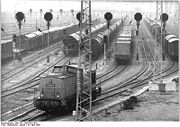
Goods station
Encyclopedia

A station where goods are not specifically received or dispatched, but simply transferred on their way to their destination between the railway and another means of transport, such as ships or lorries, may be referred to as a transshipment station. This often takes the form of a container terminal
Container terminal
A container terminal is a facility where cargo containers are transshipped between different transport vehicles, for onward transportation. The transshipment may be between container ships and land vehicles, for example trains or trucks, in which case the terminal is described as a maritime...
and may also be known as a container station.
Location
Goods stations may be located:- next to a passenger station (either on the far side of the platforms as seen from the station building or immediately alongside it),
- separately from the associated passenger station on one of the railway lines leading from it,
- as an independent facility not connected with any particular passenger station.
Where individual goods wagons are dispatched to specific goods stations, they are usually delivered to special shunting stations or marshalling yards where they are sorted and then collected. Sometimes there are combined shunting and goods stations.
Equipment

Stations where the primary purpose of the station is the handling of containers are also known as container terminal
Container terminal
A container terminal is a facility where cargo containers are transshipped between different transport vehicles, for onward transportation. The transshipment may be between container ships and land vehicles, for example trains or trucks, in which case the terminal is described as a maritime...
s (CT). They are equipped with special cranes and fork-lift vehicles for loading containers from lorries or ships onto the railway vehicles, or vice-versa.
If only a small section of a station is used for the loading and unloading of goods, it may be referred to as the "loading area" or "loading dock" and has its own access and signposting. Often there are no facilities for loading and the individual firm has to organise its own loading equipment such as conveyor belts or lorry cranes.
Such loading areas were mainly to be found on branch lines, narrow gauge
Narrow gauge
A narrow gauge railway is a railway that has a track gauge narrower than the of standard gauge railways. Most existing narrow gauge railways have gauges of between and .- Overview :...
railways and at smaller stations.
Medium-sized and larger goods stations usually have marshalling or shunting sidings to enable trains to be divided amongst the various local loading and sorting sidings and industrial branches, at the same time performing the function of a small railway hub. In many European countries they are also equipped with a hump yard.
Changing nature of goods stations

European terminology
In German-speaking countries, various terms for goods station are used including Güterbahnhof in GermanyGermany
Germany , officially the Federal Republic of Germany , is a federal parliamentary republic in Europe. The country consists of 16 states while the capital and largest city is Berlin. Germany covers an area of 357,021 km2 and has a largely temperate seasonal climate...
(abb: Gbf) and Switzerland
Switzerland
Switzerland name of one of the Swiss cantons. ; ; ; or ), in its full name the Swiss Confederation , is a federal republic consisting of 26 cantons, with Bern as the seat of the federal authorities. The country is situated in Western Europe,Or Central Europe depending on the definition....
(abb: GB), Frachtenbahnhof (Fbf) in Austria
Austria
Austria , officially the Republic of Austria , is a landlocked country of roughly 8.4 million people in Central Europe. It is bordered by the Czech Republic and Germany to the north, Slovakia and Hungary to the east, Slovenia and Italy to the south, and Switzerland and Liechtenstein to the...
; Umschlagbahnhof (Ubf) for transshipment station and Containerbahnhof or Containerterminal (CT) for container station or terminal.
See also
- Goods shedGoods shedA goods shed is a railway building designed for storing goods before or after carriage in a train.A typical goods shed will have a track running through it to allow goods wagons to be unloaded under cover, although sometimes they were built alongside a track with possibly just a canopy over the door...
- Goods train
- Railway station, which includes information on passenger stations.
- Container terminalContainer terminalA container terminal is a facility where cargo containers are transshipped between different transport vehicles, for onward transportation. The transshipment may be between container ships and land vehicles, for example trains or trucks, in which case the terminal is described as a maritime...

